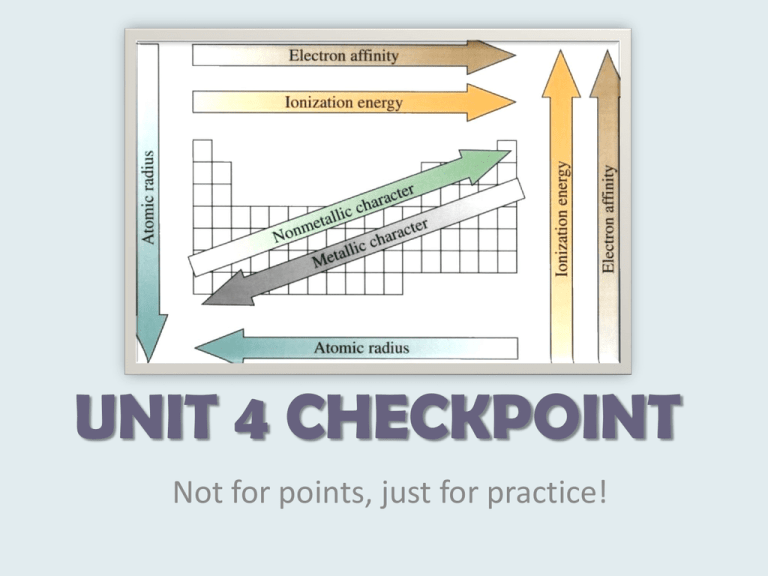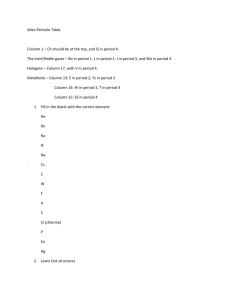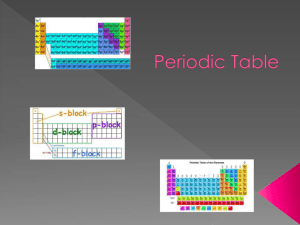Unit 4 Review - Solon City Schools
advertisement

UNIT 4 CHECKPOINT Not for points, just for practice! Which of the elements would be the least reactive metal? 4 5 6 7 8 9 10 21 22 23 24 25 26 27 28 29 30 11 12 13 15 16 ne s 17 18 fu r 0% 16 -S ul iu m e or in co n 14 0% ag 3 0% 12 -M 2 13 -A lu 1 0% 14 -S ili in um 0% 17 -C hl 13-Aluminum 14-Silicon 17-Chlorine 12- Magnesium 16-Sulfur m 1. 2. 3. 4. 5. 19 20 Which element in period 4 will have the highest electronegativity? 1. 2. 3. 4. 5. 0% 0% 0% 0% 0% Potassium Calcium Germanium Selenium Bromine 1 2 3 4 5 6 7 8 9 10 21 22 23 24 25 26 27 28 29 30 11 12 13 14 15 16 17 18 19 20 Which element in period 4 will have the largest atomic radius? 1. 2. 3. 4. 5. 0% 0% 0% 0% 0% Potassium Calcium Germanium Selenium Bromine 1 2 3 4 5 6 7 8 9 10 21 22 23 24 25 26 27 28 29 30 11 12 13 14 15 16 17 18 19 20 Which element in period 4 will have the lowest ionization energy? 1. 2. 3. 4. 5. 0% 0% 0% 0% 0% Potassium Calcium Germanium Selenium Bromine 1 2 3 4 5 6 7 8 9 10 21 22 23 24 25 26 27 28 29 30 11 12 13 14 15 16 17 18 19 20 Which element in period 4 will have 4 valence electrons? 1. 2. 3. 4. 5. 0% 0% 0% 0% 0% Potassium Calcium Germanium Selenium Bromine 1 2 3 4 5 6 7 8 9 10 21 22 23 24 25 26 27 28 29 30 11 12 13 14 15 16 17 18 19 20 Which element in period 4 will have an oxidation number of 1-? 1. 2. 3. 4. 5. 0% 0% 0% 0% 0% Potassium Calcium Germanium Selenium Bromine 1 2 3 4 5 6 7 8 9 10 21 22 23 24 25 26 27 28 29 30 11 12 13 14 15 16 17 18 19 20 Who proposed the theory that properties of elements are periodic functions of their atomic numbers? 6 7 8 9 10 21 22 23 24 25 26 27 28 29 30 11 12 14 15 16 le e 17 18 0% an ic v y in er 13 0% Pe h 5 0% M en de 4 Do be 3 re la 2 Ne w 1 0% le 0% M os e Newlands Dobereiner Moseley Mendeleev Pehanic nd s 1. 2. 3. 4. 5. 19 20 32-Germanium is in what family of the periodic table? Alkali Metals Alkaline Earth Metals Transition Metals Inner Transition Metals Post Transition Metals Halogens Noble Gases Metalloids Other Nonmetals 1 2 3 4 5 6 7 8 9 10 21 22 23 24 25 26 27 28 29 30 11 0% 0% 0% 0% 0% 0% 0% 0% 0% Al ka li M Al et ka al s lin e E Tr ar an th ... s it io nM In et ne ... rT ra ns Po iti st ... Tr an sit io ... Ha lo ge ns No bl eG as es M e Ot ta he llo rN id s on m et al. .. 1. 2. 3. 4. 5. 6. 7. 8. 9. 12 13 14 15 16 17 18 19 20 56-Barium is in what family of the periodic table? Alkali Metals Alkaline Earth Metals Transition Metals Inner Transition Metals Post Transition Metals Halogens Noble Gases Metalloids Other Nonmetals 1 2 3 4 5 6 7 8 9 10 21 22 23 24 25 26 27 28 29 30 11 0% 0% 0% 0% 0% 0% 0% 0% 0% Al ka li M Al et ka al s lin e E Tr ar an th ... s it io nM In et ne ... rT ra ns Po iti st ... Tr an sit io ... Ha lo ge ns No bl eG as es M e Ot ta he llo rN id s on m et al. .. 1. 2. 3. 4. 5. 6. 7. 8. 9. 12 13 14 15 16 17 18 19 20 An atom of sodium has 11 protons, 12 neutrons, and 10 electrons. What is its mass number? 1. 2. 3. 4. 0% 0% 0% 0% 21 22 23 22.989 1 2 3 4 5 6 7 8 9 10 21 22 23 24 25 26 27 28 29 30 11 12 13 14 15 16 17 18 19 20 37-Rubidium would have all of the following characteristics except? 9 10 21 22 23 24 25 26 27 28 29 30 11 12 14 at Br 15 16 17 . 0% Ele c.. en ce it t le Ro om ne ... ... il. .. le M al 13 18 al 8 0% 1V 7 0% id 6 Hi gh 5 Hi gh 4 ab uc tiv 3 Co nd 2 Hi gh 1 0% So l High Conductivity High Malleability High Brittleness Solid at Room Temperature 0% 1 Valence Electron ... 1. 2. 3. 4. 5. 19 20 34-Selenium would have how many valence electrons? 1. 2. 3. 4. 5. 0% 0% 0% 0% 0% 2 4 6 7 8 1 2 3 4 5 6 7 8 9 10 21 22 23 24 25 26 27 28 29 30 11 12 13 14 15 16 17 18 19 20 Which of the following is a nonmetal? 1. 2. 3. 4. 5. 0% 0% 0% 0% 0% 3-Lithium 16-Sulfur 49-Indium 51-Antimony 58-Cerium 1 2 3 4 5 6 7 8 9 10 21 22 23 24 25 26 27 28 29 30 11 12 13 14 15 16 17 18 19 20 What is the oxidation number for 20-Calcium? 1. 2. 3. 4. 5. 6. 0% 0% 0% 0% 0% 0% 1+ 2+ 6+ 126- 1 2 3 4 5 6 7 8 9 10 21 22 23 24 25 26 27 28 29 30 11 12 13 14 15 16 17 18 19 20 Which element is most likely manmade (not naturally occurring)? 1. 2. 3. 4. 5. 0% 0% 0% 0% 0% 5-Boron 17-Chlorine 38-Strontium 46- Palladium 95-Americium 1 2 3 4 5 6 7 8 9 10 21 22 23 24 25 26 27 28 29 30 11 12 13 14 15 16 17 18 19 20 How many valence electrons do the transition metals have? 1. 2. 3. 4. 5. 20% 20% 20% 20% 20% One valence electron Two valence electrons Three valence electrons Variable number of valence electrons Zero valence electrons 1 2 3 4 5 6 7 8 9 10 21 22 23 24 25 26 27 28 29 30 11 12 13 14 15 16 17 18 19 20







